Geology students explore heartbeat of Hawai'i
by joey |
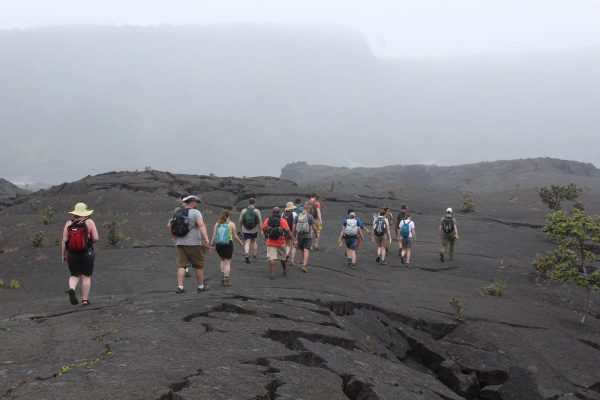
Students in Terry Naumann's volcanology course trek to a 400-foot deep crater on the east flank of the Mauna Ulu shield volcano. (Photo courtesy of Jed Long)
If you're looking for lava, then Volcano, Hawai'i seems like a pretty reasonable place for a base camp. And renting homes at 4,000 feet in a tropical cloud forest certainly sweetens the deal.
This May, right after graduation, 19 UAA students flew to the Aloha State for a 10-day tour of Hawai'i's unique and incredibly recent geology, alongside professor Terry Naumann.
Hawaiian heartbeat
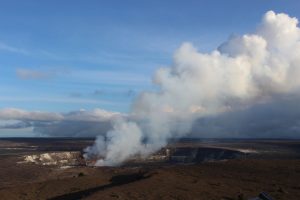
Sulfur gas and steam rise from the caldera at Kilauea. (Photo courtesy of Jed Long)
Alaska is home to more than 10 percent of the world's active volcanoes, including Mount Redoubt, only about 100 miles from Anchorage, which last erupted in 2009. Considering some of the nation's most active volcanoes are just across the water from downtown, volcanology is definitely an important subject for UAA students to research.
But, for logistical and financial reasons, none of Alaska's 100+ noted volcanoes are easily accessible for students. Considering the only viable transportation is a helicopter-which can run thousands of dollars per hour to rent-there's just no affordable way for large groups of students to get up close with a volcano in Alaska.
Hawai'i volcanoes, it turns out, are both cheaper and easier to reach than anything at home. "But you really don't need a reason to go to Hawai'i, do you?" asked Terry.
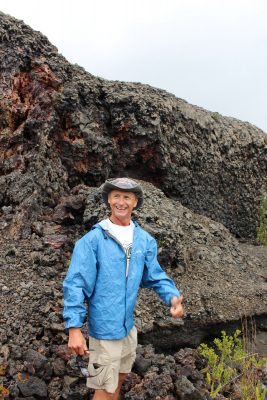
Terry Naumann joined UAA's geology department in 1999. This was his ninth summer field course in Hawai'i. (Photo courtesy of Jed Long)
After a career of volcano research, Terry has plenty of connections on the islands that both financially and academically benefit his students. An extra $750 course fee covered transportation, housing and even inter-island airfare for the students. And Terry's local friends (and fellow volcanologists) stepped in to offer guest lectures and increased access throughout the trip.
But you don't really need an excuse to study volcanoes either, do you? Active lava rocketing from the depths is just cool.
"If you want to hook somebody on geology, I don't care how jaded they are, you bring them up close to lava," Terry said. "It resets what they think hot is for the rest of their lives. Many of the places I take students to see geology, the rocks are dead, dry and static, but not hot lava. This stuff is the heartbeat of the planet."
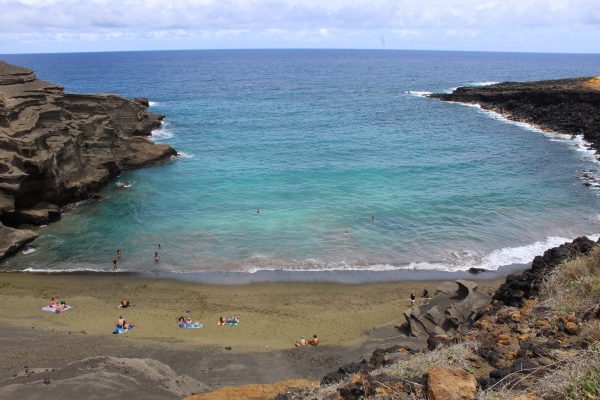
Pulverized olivine crystals built the Big Island's famous green sand beach, on the southern flanks of the Mauna Loa volcano. (Photo courtesy of Jed Long)
The beach is the classroom
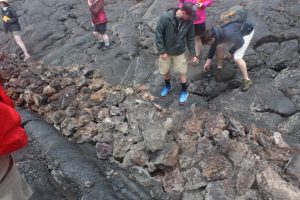
Students explore a cattle wall completely engulfed by a lava flow on the Saddle Road, between Mauna Loa and Mauna Kea volcanoes on the Big Island. (Photo courtesy of Jed Long)
The field trip started in Honolulu, known more for its crowds and traffic than its geology. But, at roughly 2-3 million years old, the young island of O'ahu is no longer adding new volcanic land and is instead starting to sink and erode, exposing deep cuts through thousands of lava flows. Terry's friend Mike Garcia-a professor at University of Hawai'i-brought the students on a tour of southeastern O'ahu, where erosion has cut deeply into the old guts of a former volcano. "It's like a mini-grand canyon, but it's all lava," Terry noted.
Next, it was off to the Big Island, to see the earth in action from the sleepy little village of Volcano. The youngest of Hawai'i's eight main islands is still volcanically active. "It's like looking at a cake and seeing only the frosting," Terry explained, contrasting the young rocks of the Big Island with the eroding lava beds on O'ahu. "These [students] got to see stuff that's younger than them, and that's rare."
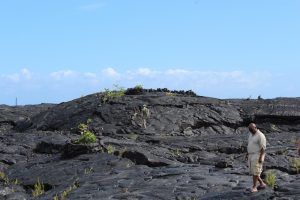
Students traverse a pahoehoe lava flow, created in 2009-2010 by a lava tube from Kilauea. (Photo courtesy of Jed Long)
When Terry started the Hawai'i trip in 2000, students could actually watch as lava boiled out of underground lava tubes (or, as Terry refers to them, "subterranean subway systems" that deliver lava to the ocean). Lately, he joked, "the volcano is not cooperating." Instead of getting up close, he brought this year's students on a nighttime visit to the Hawai'i Volcano Observatory, where another of his geologist friends-Frank Trusdell-let the students into the control tower to watch lava splash, sizzle and snap from the open earth.
The packed itinerary included a diverse range of volcanic landscapes. One day students took a rainforest hike that circled down into a steaming crater, and another day they mapped the flows and formations of a hardened lava field. They later visited a geothermal power plant to learn how Hawai'i converts boiling subterranean heat into clean renewable energy. And, of course, there was always time for swimming.
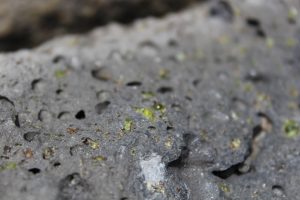
Olivine crystals embedded in the lava flows near the green sand beach. (Photo courtesy of Jed Long)
"It's Hawai'i. The beach is geology," Terry said. He took the class to a secluded green sand beach but, before anyone could dive in, they had to talk about the sand's unique composition.
"The green sand beach was formed by phenocrysts of olivine that had eroded out of a cinder cone," explained geology senior Kelsey Tucker. "It was one of the most beautiful places I have ever been, and the fact that the sand was the result of volcanic activity made it even cooler."
The intricacies of ʻaʻā
All told, the students crisscrossed hundreds of miles of the island by both mini-van and hiking boot over the course of a week. Was it busy? Was it beautiful? Was it worth it? Yes, all around.
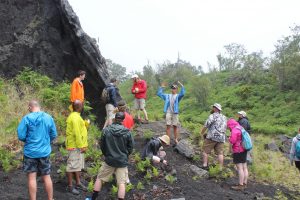
At Pu'u Hulu Hulu, Terry, in blue jacket, helped his students complete an assignment for Frank Trusdell of the Hawai'i Volcano Observatory. (Photo courtesy of Jed Long)
"Seeing the rocks and features in the wild is completely different from looking at hand samples or reading about them. It really puts things into context," said geology senior Jed Long, who will next take a two-week summer volcanology course in Kamchatka, Russia through UAF.
Kelsey agreed: "It is one thing to sit in a classroom and listen to the differences between ʻaʻā and pāhoehoe lava flows, versus being in Hawai'i and seeing and walking on the flows," she said (ʻaʻā flows are sharp, pāhoehoe flows are smooth)."You learn the differences between the two real quick when you have to walk on [them]."
For natural sciences senior Rachel Kelty, the guest lecturers from Hawai'i-Mike and Frank-added significantly to the trip. "They really have a vast amount of knowledge and passion for geology and enjoy teaching it to students," she said. "It was a great learning experience because they wouldn't just lecture you ... They would ask what we thought, or ask us to theorize on processes and make us use our brains to work it out on our own."
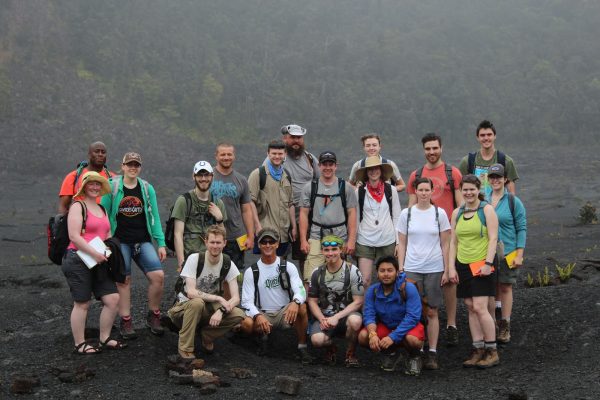
The 2016 volcanology class stopped for a group photo on the floor of Kilauea Iki crater. (Photo courtesy of Jed Long)
Real World: Volcano
Another benefit of the trip, like all field courses, is the camaraderie and inside jokes formed among the crew. It's a natural byproduct of shoving 19 students into two rental homes and three mini-vans.
"In geology you're never alone, you're working in a group setting," Terry explained, adding that the trip's close quarters provided students a taste of their future careers at research camps across Alaska.
"At the beginning I only knew one other student, but by the end I felt like we were a small family," Rachel said of her classmates, explaining the light mood surrounding every group dinner, long hike and cramped car ride.
"The hands on learning was a unique experience and the things I learned will stick with me for a long time," she added.
"The trip was one of the most memorable experiences I've ever had."
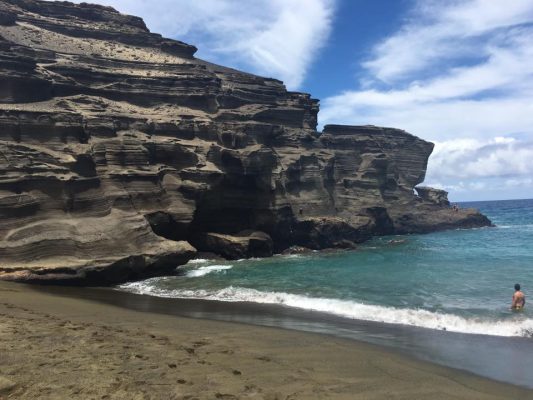
The beach is the classroom on Naumann's biannual volcanology course. (Image courtesy of Kelsey Tucker)
Read about Terry's field class to the American Southwest-held in odd-numbered years-in this 2015 story.
Written by J. Besl, UAA Office of University Advancement
 "Geology students explore heartbeat of Hawai'i" is licensed under a Creative Commons Attribution-NonCommercial 4.0 International License.
"Geology students explore heartbeat of Hawai'i" is licensed under a Creative Commons Attribution-NonCommercial 4.0 International License.









